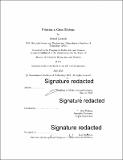| dc.contributor.advisor | Neri Oxman. | en_US |
| dc.contributor.author | Lizardo, Daniel (Daniel H.) | en_US |
| dc.contributor.other | Program in Media Arts and Sciences (Massachusetts Institute of Technology) | en_US |
| dc.date.accessioned | 2018-11-15T16:36:00Z | |
| dc.date.available | 2018-11-15T16:36:00Z | |
| dc.date.copyright | 2018 | en_US |
| dc.date.issued | 2018 | en_US |
| dc.identifier.uri | http://hdl.handle.net/1721.1/119087 | |
| dc.description | Thesis: S.M., Massachusetts Institute of Technology, School of Architecture and Planning, Program in Media Arts and Sciences, 2018. | en_US |
| dc.description | Cataloged from PDF version of thesis. | en_US |
| dc.description | Includes bibliographical references (pages 86-90). | en_US |
| dc.description.abstract | In this thesis, I explore relationships between form generation, material properties, and design constraints in search of a new framework for designing with unpredictable or unstable material systems using glass 3D printing as a case study. Molten glass forming has always been difficult to accurately predict or model, but also offers a high degree of geometric complexity or hierarchy through organic formations. Top-down design approaches to material tunability and control are enabled by new digital fabrication tools and technologies that offer some of most successful attempts to design at scales approaching that of nature [38] [20]. Bottom-up, material-driven systems design functionality, itself, around organically formed structures to challenge our perspective of designing for utility, and how to define that utility [18]. The glass 3D printer, developed by The Mediated Matter Group in collaboration with the MIT Glass Lab, has been an important case study long in the making. A novel type of glass forming quickly gave way to a dialogue with highly unstable material behaviors, structures too complex to model in real time and visually compelling, frozen in time with cooling temperatures. The process generates new types of glass structures and visual output, enabling new design typologies for the product and architectural scale. Here I present an array of over a hundred unique design experiments that offer insight into this brand new design space created by complex glass behavior under control of a digital machine and harnessing structural instability. Close study not only of the objects generated but also their behavior during fabrication is key to understanding how the glass responds to the motion of the machine. Analysis of the project workflow itself provides the foundation for a framework capable of handling an active and complex material system, identifying how and when machine control can be used directly, how and when organic material formation can take place, and how the two interface from design tool to fabrication tool to design product. Finally, I look ahead to the potential for new product and architectural functionalities enabled by this platform, and I establish concepts for using the highly complex forms with the mapped "design space" as a guide for what we understand to be possible. The goal is to form new knowledge about material-informed digital fabrication through the generation of new glass forms and designs. | en_US |
| dc.description.statementofresponsibility | by Daniel Lizardo. | en_US |
| dc.format.extent | 90 pages | en_US |
| dc.language.iso | eng | en_US |
| dc.publisher | Massachusetts Institute of Technology | en_US |
| dc.rights | MIT theses are protected by copyright. They may be viewed, downloaded, or printed from this source but further reproduction or distribution in any format is prohibited without written permission. | en_US |
| dc.rights.uri | http://dspace.mit.edu/handle/1721.1/7582 | en_US |
| dc.subject | Program in Media Arts and Sciences () | en_US |
| dc.title | Printing a glass ecology | en_US |
| dc.type | Thesis | en_US |
| dc.description.degree | S.M. | en_US |
| dc.contributor.department | Program in Media Arts and Sciences (Massachusetts Institute of Technology) | en_US |
| dc.identifier.oclc | 1059451508 | en_US |
